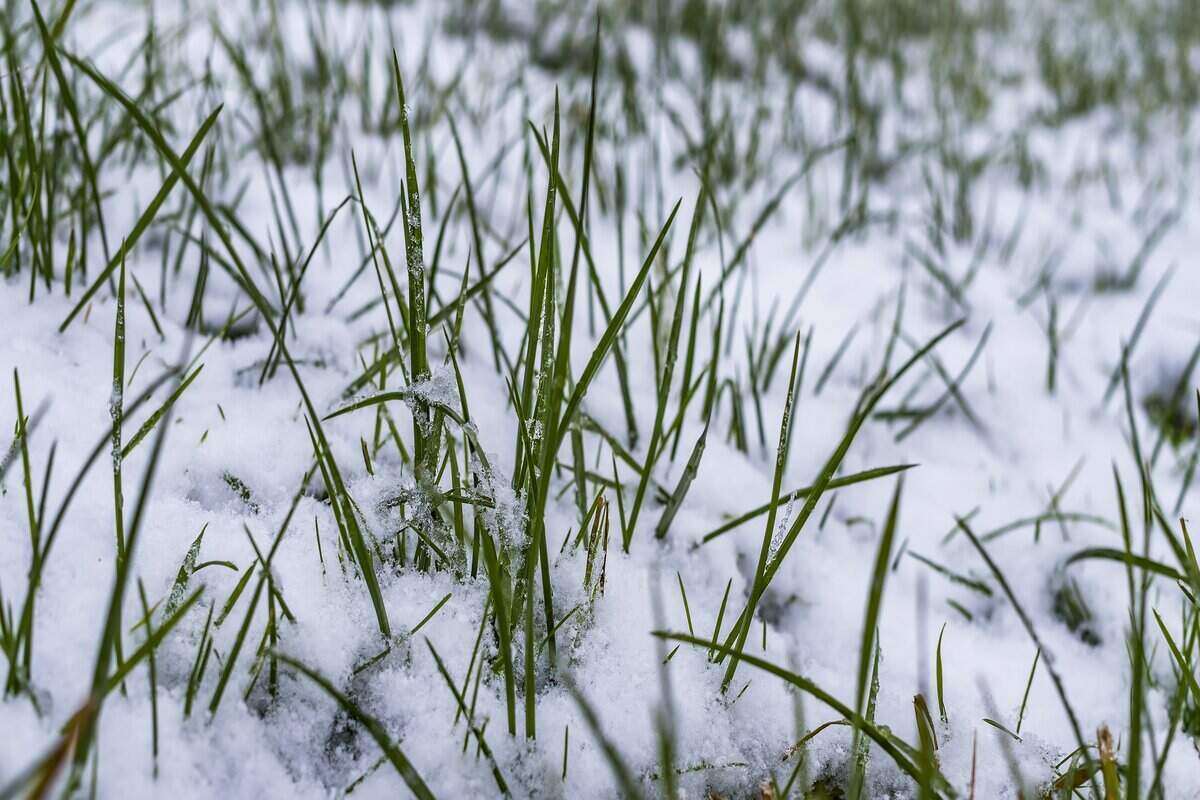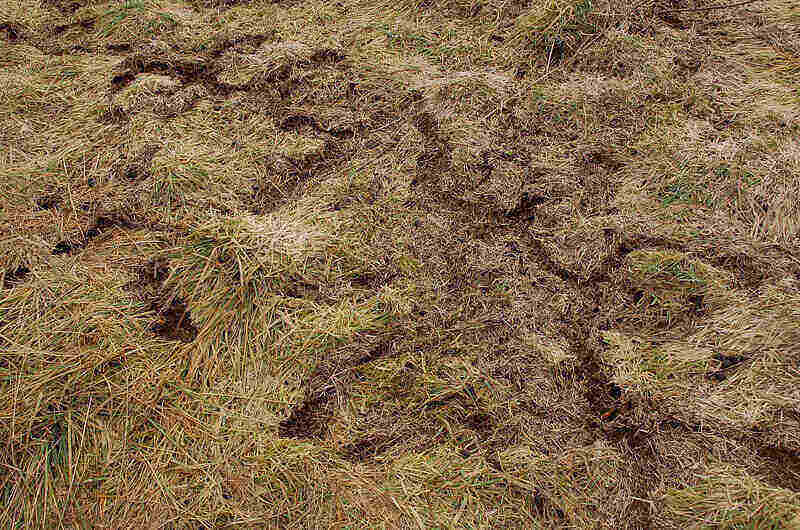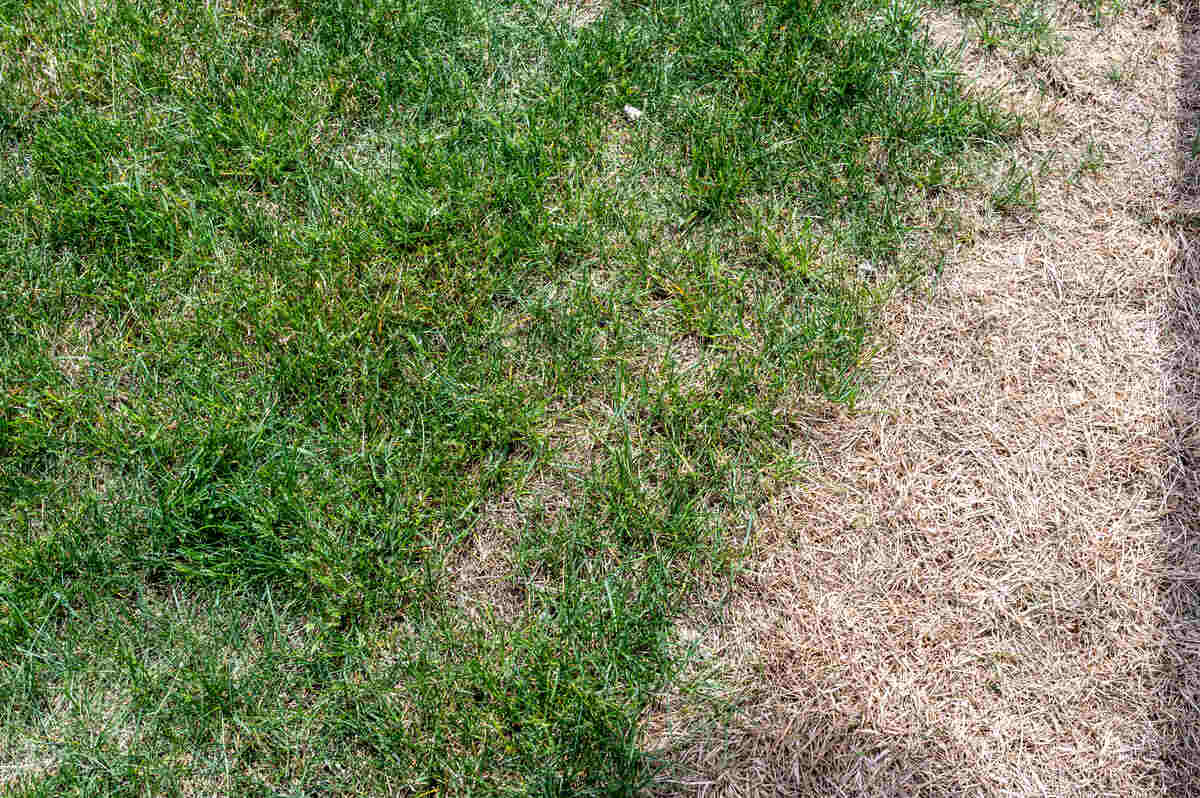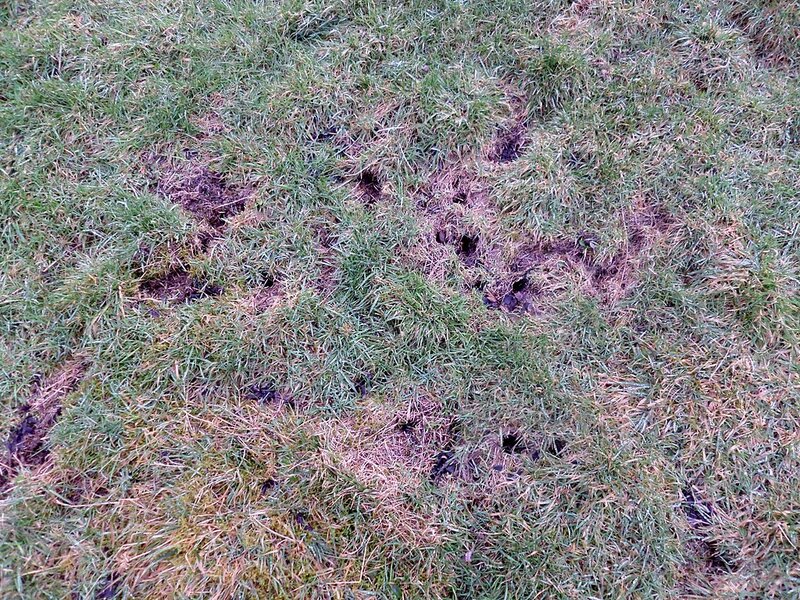
A few years back, snow mold and salt runoff turned Bob Coulston’s lawn into a patchy, gray mess. He started repairs in the spring. Early summer? The lawn was looking green and thick again.
What did he do? He did some basic spring lawn care tasks, like raking, aerating, and overseeding his lawn. We’ll tell you how to repair winter’s damage on your lawn, learning from homeowners’ experiences and expert advice from one of LawnStarter’s best lawn care pros.
- 1. Wait for Warm Soil
- 2. Remove Debris and Dead Material
- 3. Assess and Identify Causes of Winter Damage
- 4. Treat any Fungal Diseases
- 5. Repair Critter Damage
- 6. Treat Salt Damage
- 7. Aerate (If Necessary)
- 8. Overseed Bare and Thinned Patches
- 9. Apply Starter Fertilizer (Not Weed and Feed)
- 10. Water, Water, Keep Watering
- 11. Don’t Walk on Recovering Areas
- 12. Begin Mowing at Proper Height
- How Long Until You See Results?
1. Wait for Warm Soil
Coulston, a homeowner and founder of Coulston Construction in Kansas City, Missouri, timed his raking, aerating, and overseeding with the natural greening of his lawn, a sure sign that the soil temp is ideal for repairs.
“I’ve learned from experience that doing it too early just leads to wasted seed and patchy results,” says Coulston.
These tasks, along with warm soil, are a good mix for repairing winter damage. You need healthy grass tough enough to handle raking and aeration, and soil warm enough to germinate grass seed.
For cool-season (northern) grasses, like Coulston’s tall fescue, that means soil temps above 50 F for several days running. For warm-season (southern) grasses, at least 60 F. The visual cue? When you see green grass on most of your lawn’s surface, you’re good to go.
Paul Landis of ProTurf Landscape & Lawn Care in Maryland uses the last frost of spring as his guide. If your repairs include overseeding (and they often do), Landis says to wait “until after the last frost date in your geographic zone” to protect seedlings from low temperatures.
Pro Tip: Wait for the soil to thaw and dry before starting repairs (you don’t leave footprints).
2. Remove Debris and Dead Material
Best post-winter grass treatment to start with? Cleaning: unglamorous, but so effective. Remove twigs and fallen branches. Use a flexible leaf rake to clear away leaves, dead grass, and thatch. Let the sunlight reach the good grass hiding underneath. It’s been waiting all winter.
If there’s no sign of disease, toss it all in your compost bin. Weeds poking through? Pull them now. The soil is soft, the roots are shallow, and they’ll slide right out.
Note: If the thatch layer is thicker than 1/2 inch, raking won’t suffice. You’ll need to dethatch the lawn with a dethatcher (no way around it).
3. Assess and Identify Causes of Winter Damage
Before you do anything (treat, reseed, fertilize), walk your lawn and figure out what actually caused it to have dead grass after winter. Here are the top 3 causes that mess with winter lawns and the signs they leave behind:
Pink/Grey Snow Mold Gray Snow Mold Disease. Photo Credit: William M. Brown Jr., Bugwood.org / Ipmimages / CC BY 3.0 US Gray Snow Mold Disease. Photo Credit: William M. Brown Jr., Bugwood.org / Ipmimages / CC BY 3.0 US | What You See: — Circular patches of matted grass (like wet dog fur) — Grayish or slightly pink, fuzzy, web-like coating Where: — Near driveways where snow was piled — Shady spots where the snow melted last |
Vole Damage Vole Runways. Photo Credit: Jim Barton / Wikimedia Commons / CC BY-SA 2.0 Vole Runways. Photo Credit: Jim Barton / Wikimedia Commons / CC BY-SA 2.0 | What You See: — Narrow surface runways meander across the lawn, with grass chewed down or completely gone — Small round holes (burrow entrances) Where: — Near protective cover: mulch, beds, shrubs, woodpiles, tall grass |
Salt Damage Damaged grass. Photo Credit: Lost_in_the_Midwest / Adobe Stock Damaged grass. Photo Credit: Lost_in_the_Midwest / Adobe Stock | What You See: — Straw colored, tan, or brown grass — Crisp, dried-out appearance Where: — Adjacent to sidewalks, driveways, and streets — Downhill from salted surfaces |
To tell dormant from dead grass, use the “tug test”: Grab a handful of brown grass and pull gently.
- Dead grass slides right out with no resistance; remove it and toss it.
- Dormant grass holds firm. Let it be. It’s preparing to green up.
4. Treat any Fungal Diseases
As bad as it looks, snow mold is a self-limiting problem. As the soil warms, the fungus dies on its own. No chemicals required.
But you can speed up recovery. Gently rake the matted areas and break the wet clumps. Sun exposure and the warm air will kill the fungi faster.
If the damage is severe (more common with pink snow mold), you might need to overseed.
But there’s more: Don’t forget preventive treatments. If warming weather brought fungal freeloaders last year — red thread, powdery mildew, or dollar spot — now is a good time to apply fungicides.
See Related: How to Get Rid of Snow Mold
5. Repair Critter Damage

While field mice, rabbits, and deer might also munch on your grass, voles do the most severe damage to winter lawns. Don’t worry, it’s easy to repair.
- Rake the ruts to remove dead grass, thatch, and vole poop.
- Fill in burrow holes with dirt.
- Spread topsoil to level the ground.
The grass will have thinned, and some areas might show bare soil, so you’ll also need to overseed.
To get rid of voles, remove their favorite hiding places (leaf piles, wood piles, thatch) and apply repellents with capsaicin (chili pepper). You can also get a dog or call a wildlife control specialist to trap and remove them (if that’s allowed in your state).
6. Treat Salt Damage
According to the University of Toledo, icy roads can get up to nearly 2 pounds of salt per square foot each winter, and some of that inevitably leaches into your lawn. It kills grass and damages the soil. But there’s a way to repair salt damage — leaching the salt with gypsum:
- Water thoroughly (use a gentle rain shower pattern).
- Spread gypsum according to product instructions (usually 20-40 pounds per 1,000 square feet)
- Then water again, deeply, to flush the gypsum and lingering salt down through the soil, away from the grass roots.
Salt often kills the grass, so you’ll need to overseed after this treatment.
“Gypsum and two flushings with water” is the method that helped Ryan McCallister, a homeowner in Traverse City, Michigan, repair salt damage on his lawn. “Three weeks thereafter, new growth appeared,” he says.
See Related: Reducing Plant Damage from Road Rock Salt
7. Aerate (If Necessary)

Take a standard screwdriver and try to push it into moist soil. If it slides in easily, you’re fine. If you’re wrestling with it (really having to lean on it), your soil is compacted, and aeration is in order.
- For small patches, a garden fork does the job. Just drive it in and rock it back and forth to create fissures in the soil.
- For larger areas (like, say, half your lawn), rent a core aerator. It pulls out plugs of soil, leaving behind openings that grass seeds can shelter in and roots can easily colonize.
Pro Tip: Plan to aerate your cool-season lawn this coming fall. Landis says it prepares the lawn for the cold season and limits the risk of winter damage before it happens.
See Related: How to Aerate Your Lawn
8. Overseed Bare and Thinned Patches
Does grass die in winter? Some of it will, leaving bare patches and thinned spots that you need to overseed. These steps ensure you’ll get the best results:
- Use a rake or a garden fork to rough up the top few inches of soil.
- Spread a thin layer of garden soil or compost, as Coulston used. Add more in low spots to level the ground.
- Then, spread the seed. Use a hand-held spreader for small patches and a drop spreader for larger areas.
- Rake it to ensure good contact with the soil.
For larger bare patches affected by winter kill, installing sod is faster. Just give it a light tamp so the roots meet the soil.
See Related: How to Overseed a Lawn in 8 Simple Steps
9. Apply Starter Fertilizer (Not Weed and Feed)

“Use only starter fertilizer for establishing grass in the spring,” Landis says. No shortcuts. No multitaskers. Just starter fertilizer designed for the job at hand.
“Store-bought fertilizers for early spring often include crabgrass control, which contains a pre-emergent weed control chemical to prevent seed germination,” Landis explains.
These convenient weed and feed products don’t discriminate. They’ll block crabgrass from sprouting, yes, but they’ll also prevent your grass seed from germinating.
10. Water, Water, Keep Watering
Water the seeded area immediately after planting. Use a garden hose set to a rain shower pattern — anything stronger and you’ll wash away the seeds. Keep it on for 5-10 minutes to moisten the top few inches, stopping if water starts to pool.
Then comes the crucial part: keeping those seeds moist. Water 2-3 times daily, with 1/8 to 1/4 inch per session until seedlings emerge.
“You should look for new grass growth in 10-14 days,” says Landis. That’s your average timeline. Perennial rye might germinate in as little as 5 days, while Kentucky bluegrass can take up to 30 days.
Reduce watering gradually once most of the new grass has emerged. Water every other day for a week, then reduce to once every two days. By the time the grass is established (2 to 3 inches tall), return to the regular watering schedule and “water every 3 days absent of rainfall,” says Landis.
See Related: How Often to Water Grass Seed
11. Don’t Walk on Recovering Areas
Stay off freshly seeded areas until the new grass is tall enough to mow — typically 3-4 inches, or 6 to 8 weeks after seeding. Why wait?
Your body weight compacts the soil with every step (lawn equipment does far worse), creating a crust that makes it harder for seedlings to emerge. And once they do emerge? Young grass crushes so easily; your feet will kill grass plants before they have a chance to grow.
See Related: How to Care for New Grass
12. Begin Mowing at Proper Height
Ready for foot traffic means ready for mowing. Set the mower blades close to the high end of the recommended mowing height for your grass type. Taller grass will better handle the summer heat and drought. And the following cold season.
Pro Tip: Sharpen your mower blades. Young grass tears easily with a dull blade, leaving ragged edges that stress the plant and invite disease.
How Long Until You See Results?
Here’s an estimated timeline pieced together from experts and battle-scarred homeowners:
- New grass emerges in 1 week to a month, depending on the grass type and weather.
- Patches fill in decently by 2 months (though newly planted patches may stand out with a slightly different color and texture).
- At 3 to 4 months, you’ve got continuous coverage and a good-looking lawn.
When to Call a Pro
If you see little growth after a month, or you’re dealing with severe winter damage, call in help. Contact a LawnStarter lawn care pro to get your lawn ready for the outdoor season.
Sources:
- Bob Coulston, founder of Coulston Construction, Kansas City, MO. Personal interview.
- Paul Landis, Platinum LawnStarter pro and owner of ProTurf Landscape & Lawn Care, Linthicum Heights, MD. Personal interview.
- Ryan McCallister, President and Founder of F5 Mortgage, Traverse City, MI. Personal interview.
- “Study Shows Critical Need to Reduce Use of Road Salt in Winter, Suggests Best Practices.” By Christine Billau, marketing and communications specialist. University of Toledo.
- “Amelioration of Salt Damage to Cotoneaster By Gypsum.” By Michael A. Dirr, associate professor and research technician, Department of Horticulture, University of Illinois, and JoAnn Biedermann, associate professor and research technician, University of Illinois. International Society of Arboriculture.
Main Image: Green grass covered with snow. Image Credit: Pixabay